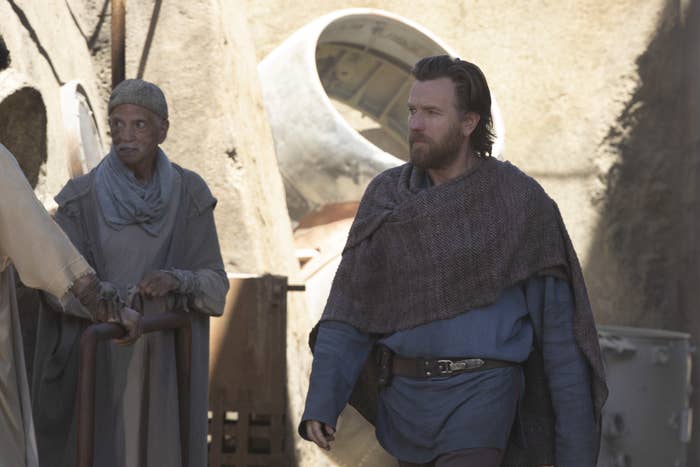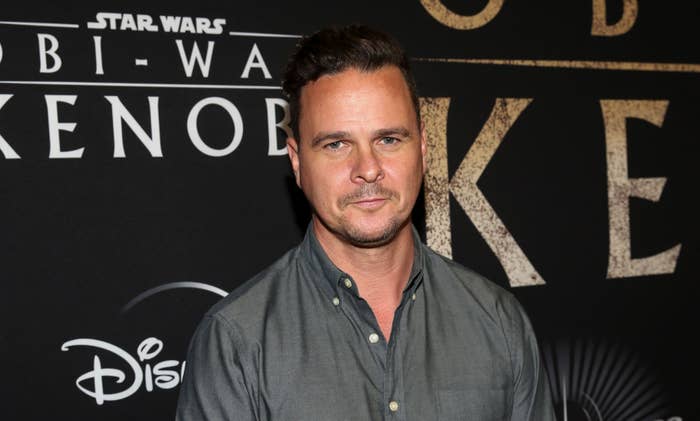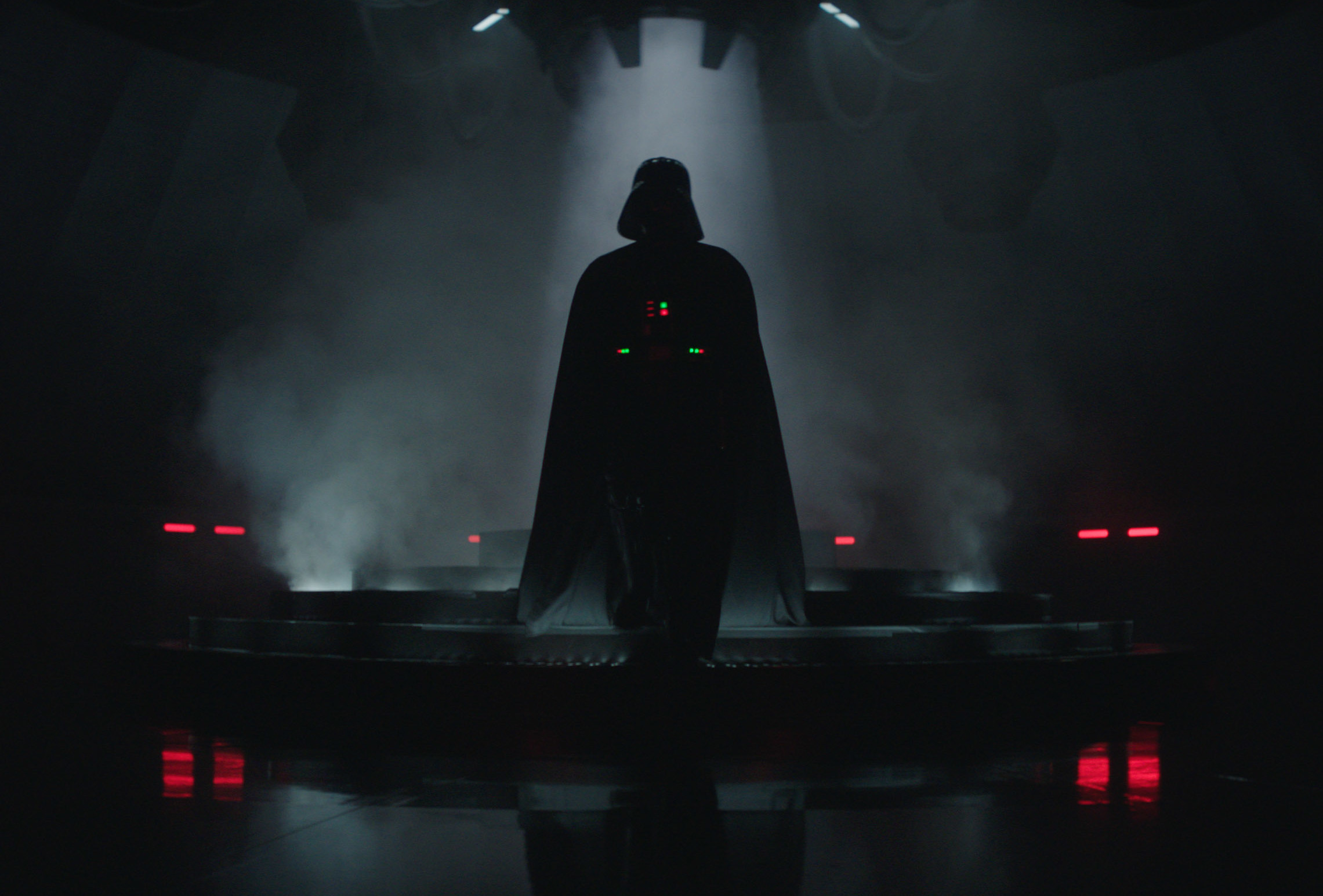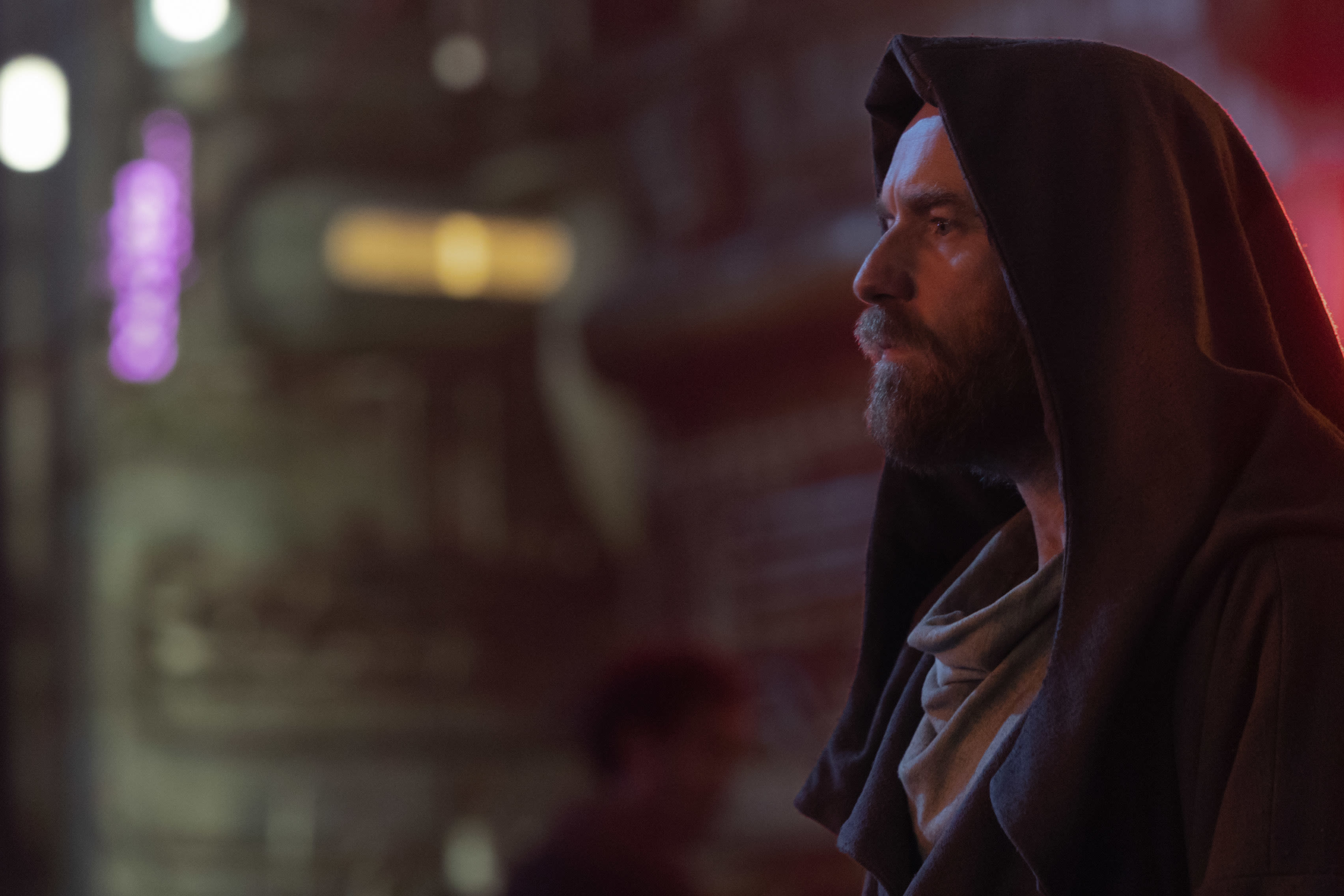
Spoilers through Episode 3: “Part III” of Disney+’s Obi-Wan Kenobi below. You’ve been warned!
The plot and pace of Disney+ and LucasFilm’s Star Wars miniseries Obi-Wan Kenobi are heating up. This week’s episode, simply titled “Part III,” brought the main event: The first—but certainly not last—fight between Obi-Wan Kenobi (Ewan McGregor) and the man known as Darth Vader (Hayden Christensen). Imagine Kenobi’s shock upon realizing the man he thought he killed is not only very much alive—but considerably more powerful than before.
The events of “Part III” were what Disney and LucasFilm have long teased about the series, so who better to speak to about how it all came together than series writer Joby Harold? Harold hasn’t had experience in the Star Wars galaxy before, but isn’t a stranger to the world of franchises; he executive produced the third John Wick film, wrote the upcoming Transformers: Rise of the Beasts, and worked on part of The Flash movie set to release next year. Oh, and he’s worked with Christensen before on the 2007 thriller Awake.
Complex spoke with Harold about how he got involved in Kenobi, his creative partnership with series director Deborah Chow, the decision on which characters should be in the story, and much more.

How did you get involved in Obi-Wan Kenobi?
Joby Harold: I’ve always been a huge Star Wars fan, right from the off when I was a kid. It was my obsession and one of the reasons—if not the main reason—why I wanted to go work in film and television. When I finally got to and moved out to America and got some good fortune, Star Wars was always the thing I really wanted to end up doing. I felt extremely lucky to be a part of it. I got to meet with the guys at LucasFilm, and we got along very well. They asked me what I thought of this character, and it’s just always been one of my favorite characters. It was the character that when I was young—and all of us for the original trilogy people—really just pulled back the curtain, took our hands, and said, “Come with me, and I’ll show you a new world, a new galaxy and everything that George built.”
Getting to contribute to the legacy of that character was really fun. But I also felt like there was just this story that could be told, between the prequels and the original trilogy that felt very important and vital to many of the stories around it but also to audiences, that they could get to see Ewan again at this time when he was sort of the right age to play the character. There’s so much goodwill towards Ewan’s version of the character. I was just really excited about it from the beginning; I loved Deborah Chow, and we just really got along. It’s just a great opportunity.
How was the collaboration process between you and Deborah? How much of the story that we’re seeing right now was already there versus how much of it did the two of you work out together?
JH: We inherited a lot of lovely stuff from previous iterations, and those are great writers before me, but Deb and I, really right from the beginning, just share a like mind of what the character could be, where we could take the story, the arc of the character and the themes of the show. I would say it was as great a relationship as I’ve had with a director—and I’ve been lucky enough to work with a lot of great filmmakers. Deb and I, our minds just work in a very similar way. We wanted to slow things down, be methodical, and take our time with the character. I appreciated the trust that was placed in me in regards to some of the bigger choices [made in the series] and slowing things down, clearing some stuff out, just kind of really focusing on what is actually quite a simple story of a man in hiding haunted by his past, that’s gonna have to face it. Deborah and I, right from the beginning, were in lockstep about that.
You mentioned having an appreciation for Star Wars and Kenobi in particular. As a fan, was it overwhelming to be responsible for defining this new era of the character? Did you and Deb work through that together at all?
JH: I can’t speak to Deb’s journey through the beginning of it. We certainly have ended up in a very similar place of just [being] really appreciative of the opportunity. I had the beginning pinch-me moment where you can’t quite process that you’re finally getting to play in this world; it’s extraordinary. I’ve said this before, but the notion of getting to write on a page, you have to choose, am I gonna write Darth Vader? Or should I just write Vader? That’s a big choice! You sort of spend 10 minutes having lunch being like, “I think I’m just gonna write Vader. That just feels more iconic.” You feel caught up in the experience for a few days, like, “Wow, this is really something else.” I used to play with my Obi-Wan [action] figure, and now it’s the actual Obi-Wan; it feels quite momentous.
You get over that really, really, really quickly because there’s a deadline every week and you have to deliver outlines and scripts. Then you are not gonna be thinking about the pressure or the expectation. You’re just gonna be thinking about, “What’s a really good story to tell?”
Were the Leia and Vader elements already there when you came to the project or was that something you were able to bring to the table?
JH: They’re both part—obviously—of Obi-Wan’s life. I think anything was open that was contributing to his story. I didn’t want any characters to be included just to satisfy the fans or to add another legacy character. Everything had to be a part of Obi-Wan’s story and journey and arc. Leia was a really important piece of that to me, always. I was excited about her being a part of it because she is as important as Luke. The idea that Obi-Wan was always watching over Luke didn’t ring true to me. I was like, “Why aren’t you looking over Leia?” She has the same significance that Luke has, and this sort of brought that question to the audience, and Bail [Organa] gets to articulate that to Obi-Wan in the cave [in Episode 1]. She’s [Obi-Wan’s] daughter too. That’s a vital piece of cannon to explore to me. If anything’s gonna take him away from Luke, it had to be her.
The Vader of it all has to be [there]. To me, it’s like, “What’s the most potent, vital piece of storytelling?” It’s Obi-Wan facing his past. Vader is his past, and him recognizing that Anakin is alive, then the inevitability of those two things coming together: This man facing his past, Leia, Vader—all those pieces of the puzzle—they’re all contributing to that central arc that needs to connect to the prequels and the original trilogy. If [a piece] contributed to that arc, great. If it didn’t, then the question was, “Why is it there?”
How did you decide on the encounter in the third episode without having it take away from anything that comes further on down the road?
JH: Well, the expectation would always be that they would meet down the road—that Rocky and Apollo would fight at the end—and we’d see who wins. So subverting that was really important—especially when Obi-Wan, arguably, isn’t ready and Vader is so powerful, emotional, angry, and rage-filled. It felt like a juicy thing to do at the midpoint of the show, to suddenly throw them together before anybody was expecting it and to actually see what would happen. I guess now I’m thinking of—it’s a little bit like at the weigh-in before a big bout where they suddenly start going at it at the press conference. You’re like, “Whoa, you guys gotta hold on and slow down a little bit.”
It was an interesting thing to do, to put them together and to see the fight be that uneven and allow the emotionality of Vader to come through in the choices he was making within that confrontation. And just to show how frightening he is and platform that in the middle of the show so that it still has a place to grow and go. It was a lovely thing to get to imagine on the page—and an even more fun thing to watch Deb bring to life.
Were you on set when Deb filmed the fight?
JH: On the Vader/Obi-Wan stuff? That part, no. Or maybe I was? I was still writing in and out [of filming]. I remember seeing the first dailies—the way it was photographed, and sort of the location—It had a sterility to it, juxtaposed with feeling very primal. When they do finally fight, it reminded me of that airport sequence in Heat.
If you’re gonna do an Obi-Wan story, it’s the thing that has to happen. It has to be lightsaber against lightsaber. I very deliberately held Obi-Wan’s lightsaber back and didn’t have him use it, didn’t have him do a bunch of force stuff beforehand, and as much as possible kept restraining, pulling back and back so that [lightsaber reveal] would have some significance within the context of that sequence. It just seemed important.

I was struck by the decision in the third episode to have Hayden Christensen show up outside of the Vader suit. Was that a decision that came out of knowing he’d be obstructed in the Vader suit and wanting to give the audience a moment to actually see Hayden? What went into that decision?
JH: 100% needed to see it. Right from the beginning, I said, “Hayden needs to be a huge part of this.” He’s an excellent human being and a great actor; he is Vader, and he is Anakin. He knows this role. He’s spent way longer than I have thinking about this character and being in this character’s shoes. He, in every way, needed to be the face of the character for the audience. On top of that, Vader is so terrifying, but also so masked, [that] it’s very difficult to humanize the Anakin element beneath it without finding opportunities to see Anakin himself and thus for Obi-Wan to be reminded of the man beneath and the legacy of guilt. So finding opportunities to actually see Anakin and see Hayden’s face was really important.
That’s where the scene in Mapuzo is so important when Obi-Wan’s walking along and imagines Anakin looking at him. That was something that felt very potent because it’s not a catch-up flashback at the beginning of an episode or a dream sequence. It’s letting the audience in on how caught up Obi-Wan is as he’s having this conversation with Leia. You need Hayden for that.
That day was an amazing day because it was, I believe, that was Hayden’s first day. I remember sitting with him under the tent—it was very hot—before he went out. There was just such an energy on set cause Hayden was there; he was in the robe and he looked fantastic. He’s so tall; you forget how intimidating he is [until you’re] next to him, having a conversation with him. I’m legitimately intimidated by the size of the man, but he’s Hayden. He’s so lovely and so sweet. I think he was aware—and we were all aware—of the extreme excitement on set that Hayden Christiansen was here. He went out and I remember just silence and everybody just staring. That only works if you see his face.
How do you balance between incorporating bits of lore from the Clone Wars animated series—like we saw with the Quinlan Vos mention—while making the show accessible for new viewers?
JH: The fans have to be acknowledged, and canon has to be adhered to; it’s fundamentally important, as [the show] needs to belong in the greater storytelling of Star Wars. The legacy of Star Wars is so strong because the attention is paid to canon and to the authenticity of storytelling. Being a writer within that world, it’s important to wear that responsibility. Once that’s adhered to—fundamentally—this has to be a story for a general audience; [it] has to be a story for everyone. So as much as I have to be satisfied as a fan within, I also need my children to love it as much as my mom will love it as much as my neighbor will love it. Catching up the audience, from an exposition point of view, is the trickiest part of that.
They need to be caught up to understand some of the nuances of it. Some of that you let slide and say, all right, well, if they don’t get this that’s okay because there’s so much meat on the bone that they will understand and that they will embrace. You try to do both sides, but it should exist and work as a story of a man rattled by his past, who has to face it to move on. We’re all haunted; everyone’s got demons. We’re all contending with something. My mom, who’s not a Star Wars person, will see that, relate to that, find herself in that, and will hopefully be satisfied with the journey that everyone goes on to reconcile that.

Do you find it easier as a writer to have some parameters on how far out of the lines you’re allowed to draw? Like we know how the story ends for Obi-Wan, so does having a bit more structure help your process, or does it make it more challenging?
JH: No, it helps. I love the science of writing and structure. That’s how I write anyway. I really like the architecture of paradigms and features in TV—and in this case in limited series—and hitting the beats and the rhythms of each section. I find that all to be really gratifying and really fun, to be honest. The only thing that gets tricky here is the stuff you come up with that you can’t do because it violates canon or something somebody else is doing on a different show—then you get the note. Like I had a Rancor thing, which I was really excited about. Then I got an email (laughs) saying, “You can’t do the Rancor thing.” And I was like, “Why?! It’s so good.” I love Rancors—who doesn’t?
Then, inevitably I watch The Book of Boba Fett with everybody else, and I’m like, “Oh, okay. Fair enough. That explains that email.” Sometimes there are things you can’t do just cause they’re stepping on things other people are doing. Otherwise, as long as it’s cleared through [Star Wars lore master] Pablo [Hidalgo] and everybody, you’re okay. You have enough room to really explore.
New episodes of Obi-Wan Kenobi streaming Wednesdays on Disney+.


